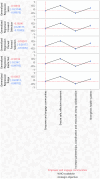Healthcare workers' priorities of WHO snakebite strategic objectives for the control and prevention of snakebite envenoming in Ghana: A machine learning statistical design of experiment modeling
- PMID: 40638704
- PMCID: PMC12262832
- DOI: 10.1371/journal.pntd.0013295
Healthcare workers' priorities of WHO snakebite strategic objectives for the control and prevention of snakebite envenoming in Ghana: A machine learning statistical design of experiment modeling
Abstract
Background: Snakebite is a severe neglected tropical disease (NTD) that affects 2.5 million people each year, resulting in the deaths of 81,000-138,000 individuals, including rural villagers, agricultural workers, and children. The World Health Organization (WHO) has set strategic objectives to halve the deaths and disabilities caused by snakebite envenoming (SBE) by 2030. This study used innovative research methods, such as the statistical design of experiments and machine learning (ML), to explore healthcare workers' priorities in Ghana regarding the WHO's strategic objectives for controlling and preventing SBE. The goal was to identify their priority needs to guide the development of a research agenda and relevant interventions or policies that prioritize local needs while aligning with the WHO's strategic objectives for SBE control and prevention.
Method: In this cross-sectional study, we employed a MaxDiff statistical design to collect data on the prioritization of the WHO strategic objectives for SBE from 137 healthcare workers in the Kwahu Afram Plains North and South districts of the Eastern Region of Ghana from August to December 2024. We divided the final dataset using a hold-back validation method, maintaining a training-to-validation ratio of 70:30. For data analysis, we utilized a diverse range of five machine learning models: Ridge Regression, Elastic Net, LASSO, a Generalized Regression Model with Pruned Forward Selection, and Forward Selection. To compare the performance of these models, we used several key metrics, including Akaike Information Criterion corrected (AICc), the Bayesian Information Criterion (BIC), the Root Average Squared Error (RASE), negative log-likelihood, and the total time taken to fit each model.
Results: The Ridge regression model appeared as the best candidate among the ML models used in this study. Its superior predictive performance justifies the computational cost it requires, making it the preferred option for applications that prioritize both predictive performance and computational efficiency. This model consistently predicted key WHO strategic objectives for preventing and controlling SBE. Of the objectives, 'Ensuring safe and effective treatment' had the highest priority, followed by 'Strengthening health systems', 'Empowering and engaging communities' and 'Increasing partnerships, coordination, and resources'. This underscores their order of importance for local initiatives. Therefore, these strategies must be prioritized when designing local policies, relevant interventions, and research agendas.
Conclusion: By utilizing a MaxDiff statistical experiment design and five machine learning models, participants prioritized the WHO strategic objectives for preventing and controlling SBE in Ghana. Our findings provide essential insights into local policy-making and intervention strategies and for shaping research agendas in Ghana. A local action plan is urgently needed, prioritizing 'Ensuring safe and effective treatment' at the community level, followed by 'Strengthening health systems', 'Empowering and engaging communities', and 'Increasing partnerships, coordination, and resources'. Prioritizing these strategies in Ghana is crucial for supporting the WHO's goal of reducing the global SBE burden by 50% by 2030. The success of these strategies hinges on the active involvement of the Ministry of Health and the Ghana Health Service in their implementation at the local level and within the health system.
Copyright: © 2025 Nyarko et al. This is an open access article distributed under the terms of the Creative Commons Attribution License, which permits unrestricted use, distribution, and reproduction in any medium, provided the original author and source are credited.
Conflict of interest statement
The authors have declared that no competing interests exist.
Figures



Similar articles
-
Comparison of Two Modern Survival Prediction Tools, SORG-MLA and METSSS, in Patients With Symptomatic Long-bone Metastases Who Underwent Local Treatment With Surgery Followed by Radiotherapy and With Radiotherapy Alone.Clin Orthop Relat Res. 2024 Dec 1;482(12):2193-2208. doi: 10.1097/CORR.0000000000003185. Epub 2024 Jul 23. Clin Orthop Relat Res. 2024. PMID: 39051924
-
Behavioral interventions to reduce risk for sexual transmission of HIV among men who have sex with men.Cochrane Database Syst Rev. 2008 Jul 16;(3):CD001230. doi: 10.1002/14651858.CD001230.pub2. Cochrane Database Syst Rev. 2008. PMID: 18646068
-
Perceptions and experiences of the prevention, detection, and management of postpartum haemorrhage: a qualitative evidence synthesis.Cochrane Database Syst Rev. 2023 Nov 27;11(11):CD013795. doi: 10.1002/14651858.CD013795.pub2. Cochrane Database Syst Rev. 2023. PMID: 38009552 Free PMC article.
-
Are Current Survival Prediction Tools Useful When Treating Subsequent Skeletal-related Events From Bone Metastases?Clin Orthop Relat Res. 2024 Sep 1;482(9):1710-1721. doi: 10.1097/CORR.0000000000003030. Epub 2024 Mar 22. Clin Orthop Relat Res. 2024. PMID: 38517402
-
Signs and symptoms to determine if a patient presenting in primary care or hospital outpatient settings has COVID-19.Cochrane Database Syst Rev. 2022 May 20;5(5):CD013665. doi: 10.1002/14651858.CD013665.pub3. Cochrane Database Syst Rev. 2022. PMID: 35593186 Free PMC article.
References
-
- WHO. Target product profiles for animal plasma-derived antivenoms: antivenoms for treatment of snakebite envenoming in sub-Saharan Africa. Geneva: World Health Organization. 2023.
-
- Kasturiratne A, Wickremasinghe AR, de Silva N, Gunawardena NK, Pathmeswaran A, Premaratna R, et al. The global burden of snakebite: a literature analysis and modelling based on regional estimates of envenoming and deaths. PLoS Med. 2008;5(11):e218. doi: 10.1371/journal.pmed.0050218 - DOI - PMC - PubMed
MeSH terms
LinkOut - more resources
Full Text Sources

